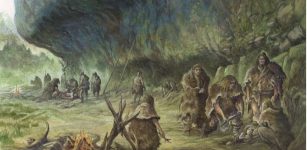How Greenland Got The ‘Wrong’ Name Thanks To Viking Erik The Red
Ellen Lloyd - AncientPages.com - Greenland is beautiful, but the massive island is not very green.
Located between the Arctic and Atlantic Oceans, east of the Canadian Arctic Archipelago, Greenland is mostly covered with ice.
The island was named after the Viking Erik the Red, who colonized Greenland. He had a good reason to call the island Greenland.
Greenland is the world's largest island. It is famous for its colossal icebergs, magical midnight sun, amazing displays of the Northern Lights, and beautiful fauna and flora. Ice sheets cover about 84% of Greenland's landmass. However, Southern Greenland lives up to its name as it is truly a green land.
Greenland is famous for its huge icebergs. Credit: EHRENBERG Kommunikation - CC BY-SA 2.0
Temperatures vary enormously, depending on the location and time of year. One can expect an average temperature in Upernavik of minus 20 degrees in February to about 10 degrees in the towns throughout the summer.
Owing to the low humidity in Greenland, summer temperatures will often feel warmer than you might otherwise expect.
Greenland was discovered by the famous Viking Erik the Red. He colonized the island, built a house on a place later called Brattalid, and served as Greenland’s “capital” for many years.
However, the Vikings were not the first people to live in Greenland. The island had been inhabited in prehistoric times by several Paleo-Eskimo cultures.
From around 2500 BC to 800 BC, southern and western Greenland were inhabited by the Saqqaq culture. Around 800 BC, the Saqqaq culture disappeared, and the Early Dorset culture emerged in western Greenland and the Independence II culture in northern Greenland.
Erik the red changed the history of this beautiful island. The harsh climate on Greenland made life difficult, but Erik the Red was determined and convinced that he could set up a colony.
He started recruiting settlers, but he knew that it would be very difficult to convince Vikings to settle in such a remote and cold place. So, Erik, the Red, cheated and told a lie to attract settlers.
He called the island Greenland and said there were plenty of good fishing reservoirs.
Beautiful Northern Lights over Greenland. Image credit: Mads Pihl, Visit Greenland, CC BY-NC-SA 4.0
More than five hundred Icelanders agreed to follow him to Greenland, but it was a very dangerous trip, and many died on the way. Only 14 of 25 Viking ships crossed the ice-cold and dangerous waters.
The survivors established several colonies across Greenland and lived as fishermen, hunters, and farmers. The Viking settlers shared the island with the late Dorset culture inhabitants who occupied the northern and western parts and later with the Thule culture that entered from the north.
Erik the Red had achieved his goal and never left Greenland again!
The name of the country in Greenlandic (Kalaallisut) is Kalaallit Nunaat which translates as "land of the Kalaallit").
The Kalaallit are the indigenous Greenlandic Inuit people who inhabit the country's western region.
Updated on January 1, 2023
Written by - Ellen Lloyd AncientPages.com
Copyright © AncientPages.com All rights reserved. This material may not be published, broadcast, rewritten or redistributed in whole or part without the express written permission of AncientPages.com
Expand for referencesMore From Ancient Pages
-
 X-Rays Reveal Secret From Da Vinci’s Masterpiece Mona Lisa
News | Oct 14, 2023
X-Rays Reveal Secret From Da Vinci’s Masterpiece Mona Lisa
News | Oct 14, 2023 -
 Hades – ‘The Unseen’ God Of The Dead, Fertility, Wealth And Earth’s Minerals
Featured Stories | Jun 2, 2020
Hades – ‘The Unseen’ God Of The Dead, Fertility, Wealth And Earth’s Minerals
Featured Stories | Jun 2, 2020 -
 Mystery Of The Hidden Shoes Discovered In Ancient European Houses – What Is Behind This Bizarre Tradition?
Featured Stories | Oct 2, 2021
Mystery Of The Hidden Shoes Discovered In Ancient European Houses – What Is Behind This Bizarre Tradition?
Featured Stories | Oct 2, 2021 -
 Why Were Ancient ‘Puppet’ Figurines Placed Atop A Pre-Columbian Pyramid In El Salvador?
Archaeology | Mar 5, 2025
Why Were Ancient ‘Puppet’ Figurines Placed Atop A Pre-Columbian Pyramid In El Salvador?
Archaeology | Mar 5, 2025 -
 Ancient ‘Cosmic’ Artifacts – Ancient Civilizations Used Meteoric Iron Much Earlier Than Previously Thought
Archaeology | Dec 6, 2017
Ancient ‘Cosmic’ Artifacts – Ancient Civilizations Used Meteoric Iron Much Earlier Than Previously Thought
Archaeology | Dec 6, 2017 -
 Early Bantu Speakers Crossed Through The Dense Central African Rainforest 4,000 Years Ago
Archaeology | Aug 2, 2022
Early Bantu Speakers Crossed Through The Dense Central African Rainforest 4,000 Years Ago
Archaeology | Aug 2, 2022 -
 Neanderthals Buried Their Dead And Developed Spirituals Beliefs – Did Neanderthals Practice Religion?
Featured Stories | Dec 28, 2016
Neanderthals Buried Their Dead And Developed Spirituals Beliefs – Did Neanderthals Practice Religion?
Featured Stories | Dec 28, 2016 -
 The Ebers Papyrus – Most Famous Plant Medicine ‘Encyclopedia’ Of Ancient Egypt
Civilizations | Feb 3, 2016
The Ebers Papyrus – Most Famous Plant Medicine ‘Encyclopedia’ Of Ancient Egypt
Civilizations | Feb 3, 2016 -
 Excavation Of A Mysterious 5,000-Year-Old Tomb Linked To King Arthur Has Started
Archaeology | Jul 5, 2022
Excavation Of A Mysterious 5,000-Year-Old Tomb Linked To King Arthur Has Started
Archaeology | Jul 5, 2022 -
 The Spread Of Weighing Systems Across Western Eurasia 4,000 Years Ago
Archaeology | Jun 30, 2021
The Spread Of Weighing Systems Across Western Eurasia 4,000 Years Ago
Archaeology | Jun 30, 2021 -
 Ancient Burial Tomb Of A Noble Mongol Warrior With Weapons Unearthed In The Moldavian Village
Archaeology | Aug 9, 2022
Ancient Burial Tomb Of A Noble Mongol Warrior With Weapons Unearthed In The Moldavian Village
Archaeology | Aug 9, 2022 -
 Surprising And Fascinating Finds On The Wreck Of The Lootsi Cog
Archaeology | Nov 27, 2023
Surprising And Fascinating Finds On The Wreck Of The Lootsi Cog
Archaeology | Nov 27, 2023 -
 Long-Lost Burial Site Of Viking King Harald Bluetooth Discovered By Satellites?
Archaeology | Jun 29, 2022
Long-Lost Burial Site Of Viking King Harald Bluetooth Discovered By Satellites?
Archaeology | Jun 29, 2022 -
 Evidence Of Ritualistic Gatherings 35,000 Years Ago Found In The Manot Cave In Galilee, Israel
Archaeology | Dec 12, 2024
Evidence Of Ritualistic Gatherings 35,000 Years Ago Found In The Manot Cave In Galilee, Israel
Archaeology | Dec 12, 2024 -
 On This Day In History: Ramesses II Became Pharaoh Of Ancient Egypt – On May 31, 1279 BC
News | May 31, 2016
On This Day In History: Ramesses II Became Pharaoh Of Ancient Egypt – On May 31, 1279 BC
News | May 31, 2016 -
 4,000-Year-Old Tomb Altóir Na Gréine Rediscovered By Folklorist In County Kerry, Ireland
Archaeology | Jan 24, 2024
4,000-Year-Old Tomb Altóir Na Gréine Rediscovered By Folklorist In County Kerry, Ireland
Archaeology | Jan 24, 2024 -
 Did Etruscans Solve The Mystery Of Synchronicity And The Secret Language Of The Stars?
Ancient Mysteries | Jul 5, 2018
Did Etruscans Solve The Mystery Of Synchronicity And The Secret Language Of The Stars?
Ancient Mysteries | Jul 5, 2018 -
 13th Century Black Book Of Carmarthen: Erased Poetry And Ghostly Faces Revealed By UV Light
Artifacts | Apr 4, 2015
13th Century Black Book Of Carmarthen: Erased Poetry And Ghostly Faces Revealed By UV Light
Artifacts | Apr 4, 2015 -
 Rare 1,000-Year-Old Viking Wooden Bowl Found By Young Boy
Archaeology | Oct 24, 2022
Rare 1,000-Year-Old Viking Wooden Bowl Found By Young Boy
Archaeology | Oct 24, 2022 -
 Acta Diurna: World’s First Newspaper Appeared In 131 B.C
Ancient History Facts | Jun 10, 2019
Acta Diurna: World’s First Newspaper Appeared In 131 B.C
Ancient History Facts | Jun 10, 2019



